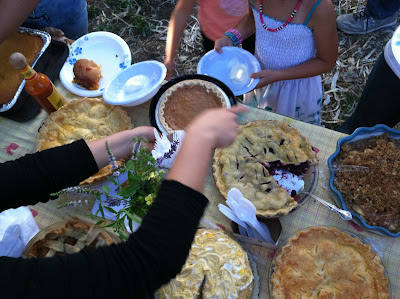If you don't already know me, then here's a newsflash: my middle name is "Do It the Hard Way." That said, the following methods for saving seeds cannot possibly be simple. But that's the way I roll.
You will need:
- dried seeds/pods
- a colander
- a bowl that the colander can rest in
- a hat or bandanna
- paper bags or envelopes (junk mail envelopes best if you want to feel resourceful)
- a magic marker
- a flexible mat, such as a kids' plastic placemat
- garden gloves
- a smooth, round stone or similar object


Radishes are among the easiest for seed-saving. First, plant non-hybrid radishes. I personally like German Giant, but I am not a radish fan. They are quick-growing and the seeds are good to have on hand for food security. When radishes are ready to harvest, select 2-3 of the best radishes (you can tell by brushing dirt from the top). Leave these in the ground and they'll bolt into a radish bush. You will soon see flowers, which will form seed pods as they're pollinated. Earwigs munch on the blossoms and pods for a midnight snack, so you may want to hand-pick, use beer/yeast traps and/or form a "doggie cone of shame" on the main stalk of the radish. In the meantime, well-meaning helpers will want to pull out your dreadful "weed." If they do, smile and say "Oh no biggie!" and buy the seeds--that helper just saved you from an hour of easy misery. Reduce watering to encourage seed formation. After 6-8 weeks the pods will dry. They will feel hard and rough like a generic animal cracker. If they are green and squishy, they aren't ready. Harvest whole plant when most pods are dry.

Seed saving is best outdoors in the shade in a place where you don't mind random veggies popping out of the ground en masse. You may want to wear gloves, especially for mustards, arugula, and other brassicas as the pods can be sharp. Place pods in colander on top of bowl (or mash entire bush in) and smash pods. Fully dried seeds will not mush while you pummel the pods. Once all pods are crushed, swirl the contents around with your hand to encourage reluctant seeds into the bowl below. Next is separating the chaff from the seeds. You may want to wear a hat. A very slight breeze can also help. Tip the bowl and gently blow the chaff (fibrous material you don't want). The hat is to keep you from looking like you've developed a clinical case of dandruff when a neighbor drops by unexpectedly. Oh yeah, you'd better close your eyes. Another option is to drop the mixture from about ten inches into the bowl and let the slight breeze help separate. Gently shimmying the bowl also forces the lighter chaff to the top, so you can skim it off. I've wondered if a blender or food processor could do some of this work for me, but I worry the seeds would get thwacked.
In the end, three radishes give me about 100 seeds. Label a paper bag (not plastic unless you're certain the seeds are dry; otherwise, you'll be sad when all your work goes moldy) with date and seed type. Carefully pour seeds into bag. Store in a cool, dry place. In a few months you'll probably be gripped by garden fever and go buy the same seeds. Oh well.

Other non-hybrid plant seeds that can be saved in similarly simple steps: beans, lettuce, broccoli, mustard, bok choy, kale, carrots, parsnips, parsley, cilantro, dill, celery, chard, and beets. Seeds from arugula, bok choy, mustard, lettuce, bok choy, broccoli and dill can be collected in the same season as they're planted. Carrots, beets, parsnips, onions and celery need to winter-over under a layer of leaves. They will form enormous bushes, so just choose one that looks the healthiest that's in a place you don't mind disappearing under 64 cubic feet (4'x4'x4') of biomass. Don't collect from one of these plants if it goes to seed in the first summer-this is an undesirable trait that you don't want to propagate. From the one kale I've collected seeds, I learned that they take two winters, but perhaps it was just an issue of the variety. For parsley, dill and cilantro, I allow a couple plants to drop their seeds and regrow.
 |
| Not sure why this fella won't turn landscape... |
 |
| Parsnip seeds (ready when stems are dry) |
Plants that are harder for seed-saving include melons, cucumbers, squash, tomatoes, peppers, eggplants and peas. The problem with peas is weevils. Even if you let 500 pods grow until they're yellow, hard and bloated, in a few weeks, you'll have 400 pea clubhouses with a circular door and a bagful of zombie weevils. Beans don't have that issue, so let them blimp on the vine, then dry in a paper back or spread in a cardboard produce box. Follow above steps.
 |
| Onion flower from last year's onion |
The difficulty in melons, squash, cucumbers, peppers, tomatoes and eggplants is cross-pollination. Some folks say there isn't cross-pollination, but most of us don't have 30'x30' garden plots devoted to a single variety of a single kind of vegetable, where plants at the center are more isolated. Of the plants in the difficult category, squash and pumpkins are the most manageable. Some day I'll add a post for that.



 We Can Do It...Again! February 19th
We Can Do It...Again! February 19th We Can Do It...Again! February 19th
We Can Do It...Again! February 19th Lettuce Be Little. February 20th.
Lettuce Be Little. February 20th. 









































